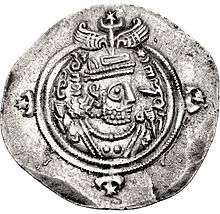Farrukh Hormizd
| Farrukh Hormizd | |
|---|---|
| Rival Great King (Shah) of Ērānshahr | |
 | |
| Reign | 630-631 |
| Predecessor | Azarmidokht |
| Successor | Azarmidokht |
| Died |
631 Ctesiphon |
| Issue |
Rostam Farrokhzad Farrukhzad |
| House | House of Ispahbudhan |
| Father | Vinduyih |
| Religion | Zoroastrianism |
Farrukh Hormizd or Farrokh Hormizd (Persian: فرخهرمز), was a spahbed in northern Persia, he was a prince of Atropatene.[1] He later came in conflict with the Sassanid nobles, "dividing the resources of the country".[2] He was later killed by Siyavakhsh in a palace plot on the orders of Azarmidokht after he proposed to her in an attempt to usurp the Sasanian throne. He had two children, Rostam Farrokhzād and Farrukhzad.
Family and origins
Farrukh Hormizd was a member of the Ispahbudhan family, one of the seven Parthian clans. He was the son of Vinduyih, a descendant of Bawi, whose sister was the wife of Kavadh I and mother of Khosrau I. Farrukh's father and uncle, Vistahm, played an important role in defeating the Mihranid Bahram Chobin and restoring Khosrau II to the throne. Khosrau, however, had Vinduyih executed, which made Vistahm revolt against him. The rebellion of Vistahm lasted from 590/1–596 or 594/5–600, until he was betrayed by one of his own generals. After the death of Vistahm, Farrukh succeeded him as the spahbed of the north.
Early career
During the late Byzantine–Sasanian War of 602–628, Farrukh, and his son Rostam Farrokhzad, rebelled against Khosrau II, allowing the Byzantine emperor Heraclius to invade Atropatene, where he sacked several cities, including the Adur Gushnasp temple.[3]
In 628, the feudal families of Persia secretly mutinied against Khosrau and joined Shahrbaraz. Kavadh was then released by the feudal families of the Sasanian Empire, which included: The House of Ispahbudhan represented by Farrukh himself, and his two sons Rostam Farrokhzad, and Farrukhzad. Shahrbaraz, who represented the Mihran family. The Armenian faction represented by Varaztirots II Bagratuni and finally the Kanarang.[4] On February, Kavadh, along with Aspad Gushnasp, captured Ctesiphon and imprisoned Khosrau II. Kavadh II then proclaimed himself as king of the Sasanian Empire on 25 February, and with the aid of his minister Piruz Khosrow, executed of all his brother and half-brothers, which included Mardanshah, the favorite son of Khosrau II. Three days later, he ordered Mihr Hormozd to execute his father. With the agreement of the Persian nobles, Kavadh then made peace with the Byzantine emperor Heraclius, which made the Byzantines regain all their lost territories, their captured soldiers, a war indemnity, along with the True Cross and other relics that were lost in Jerusalem in 614.[5][6]
Following the loss of territory required for the peace treaty, Farrukh formed an independent state within the northern part of the Sasanian Empire, which was known as the Pahlav (Parthian) faction. Piruz Khosrow also formed an independent state in southern Persia, which was known as the Parsig (Persian) faction. This divided the resources of the country which resulted in a devastating plague in the western provinces of Persia, killing half of the population along with Kavadh II who was succeeded by Ardashir III.[2]
One year later, Shahrbaraz with a force of 6,000 men,[7] marched towards Ctesiphon and besieged the city. Shahrbaraz, however, was unable to capture the city, and then made an alliance with Piruz. He also made an alliance with Namdar Jushnas, the spahbed of Nimruz.[8] Shahrbaraz, with the aid of these two powerful figures, captured Ctesiphon, and executed Ardashir III, along with his minister Mah-Adhur Gushnasp, including other Sasanian nobles like Ardabīl. Forty days later, Shahrbaraz was murdered by Farrukh, who then made Borandukht, the daughter of Khosrau II, ascend the throne.[9] Farrukh Hormizd greatly opposed Piruz and his faction.[10] Borandukht, was, however, deposed by Shapur-i Shahrvaraz, the son of Khosrau IIs sister Mirhran, and the Sasanian usurper Shahrbaraz. Shahrvaraz was shortly deposed by Piruz and his faction, who did not acknowledge his rule. Piruz then crowned Azarmidokht, the sister of Borandukht, as monarch of Persia.[11] Farrukh then declared himself as "the leader of the people and the pillar of Iran" and became king of part of Persia. He then began to mint coins at Estakhr in Pars and Nahavand in Media under name of "Hormizd V".
Usurpation and death
In order to make a union with the Parsig faction, and legitimize his power, Farrukh Hormizd asked Azarmidokht to marry him. Not daring to refuse, Azarmidokht had him killed with the aid of the Mihranid Siyavakhsh, who was grandson of Bahram Chobin, the famous spahbed and briefly shahanshah. After the death of Farrukh, Rostam Farrokhzad, his son, became the new spahbed of Atropatene and Khorasan, he then avenged his father by occupying Ctesiphon and killing Azarmidokht.
Family tree
| Bawi | |||||||||||||||||||||||||||||||||||||||||||||
| Shapur | |||||||||||||||||||||||||||||||||||||||||||||
| Vinduyih | Vistahm | ||||||||||||||||||||||||||||||||||||||||||||
| Farrukh Hormizd | Tiruyih | Vinduyih | |||||||||||||||||||||||||||||||||||||||||||
| Rostam Farrokhzād | Farrukhzad | ||||||||||||||||||||||||||||||||||||||||||||
| Shahram | Surkhab I | Isfandyadh | Bahram | Farrukhan | |||||||||||||||||||||||||||||||||||||||||
References
- ↑ http://www.iranicaonline.org/articles/boran-pers
- 1 2 SASANIAN DYNASTY, A. Shapur Shahbazi, Encyclopaedia Iranica, (20 July 2005).
- ↑ Pourshariati (2008), pp. 152-153
- ↑ Pourshariati (2008), p. 173
- ↑ Oman 1893, p. 212
- ↑ Kaegi 2003, pp. 178, 189–190
- ↑ ARDAŠĪR III, A. Sh. Shahbazi, Encyclopædia Iranica,(11 August 2011).
- ↑ Pourshariati (2008), p. 180
- ↑ Pourshariati (2008), p. 175
- ↑ Pourshariati (2008), p. 183
- ↑ Pourshariati (2008), p. 204
Sources
- Pourshariati, Parvaneh (2008). Decline and Fall of the Sasanian Empire: The Sasanian-Parthian Confederacy and the Arab Conquest of Iran. London and New York: I.B. Tauris. ISBN 978-1-84511-645-3.
- Shapur Shahbazi, A. (2005). "SASANIAN DYNASTY". Encyclopaedia Iranica, Online Edition. Retrieved 20 March 2014.
| Farrukh Hormizd Ispahbudhan | ||
| Preceded by Azarmidokht |
Great King (Shah) of Ērānshahr 630 –631 |
Succeeded by Azarmidokht |